Service Life Evaluation for RC Sewer Structure Repaired with Bacteria Mixed Coating: Through Probabilistic and Deterministic Method
Abstract
:1. Introduction
2. Service Life Evaluation of RC Sewage Structure with Bacteria-Coating Material with Deterministic and Probabilistic Methods
2.1. Governing Equation of Service Life under Sulfate Exposure
2.2. Bio-Coating Materials Mixed with Bacteria
2.2.1. Preparation of Repair Coating Material with Bacteria
2.2.2. Diffusion Coefficient of Sulfate Ion through Natural Diffusion Cell Test
3. Changing Service Life with Probabilistic Characteristics of Design Parameters
3.1. Service Life Evaluation with the Deterministic Method
3.2. Service Life Evaluation Using Probabilistic Method
3.2.1. Preparation of Bacteria-Coating Material
3.2.2. Service Life Change of Bacteria-Coating Material
- (1)
- Overview of service life evaluation of repair materials
- (2)
- Changes in failure probability and service life according to varying mean value
- (3)
- Failure probability and changes in service life according to COV
4. Service Life Changes in RC Sewage Structure with Different Repair Materials
| Repair Mortar | Bacteria-Coating Material | |
|---|---|---|
| Repair cost (USD/m2) | 49.1 | 32.9 |
5. Conclusions
- An FA-GGBFS-based repair material with Rhodobacter capsulatus was developed, which consumes sulfate ions as nutrients. For applying probabilistic service life evaluation, probability distribution characteristics were derived through diffusion cell tests and cover depth measurements. The derived diffusion coefficient of the developed repair material with Rhodobacter capsulatus showed a very low value in the level of 8.3–8.4% compared to that of the base concrete and normal repair material, and the COV was around 10%, indicating stable quality assurance.
- Five major design parameters (surface coating, coating thickness, diffusion coefficient, exterior sulfate ion concentration, and surface roughness) were defined as random variables for analyzing the service life with a probabilistic approach. The effect of the mean value of surface roughness and cover depth was evaluated to be dominant; therefore, it is important to pay special attention to the surface treatment and coating thickness during repair construction. When the service life was evaluated while increasing the COV of each design parameter from 0.1 to 0.3, the service life was reduced by 1.5 to 2.6 years, even with the application of the appropriate coating thickness, which yields a decrease in service life by more than 15%.
- When the service life of the RC sewage structure was evaluated considering under 120 ppm of exterior sulfate ingress, it was evaluated to be 21.6 years without repair, but this increased to 25.7 years with a normal repair mortar, and further increased to 42.1 years enhanced with a bacteria-coating material. When the probabilistic method was applied, it was reduced due to the low target durability probability. With the increasing COV of the design parameter, it was greatly reduced from 26.5 to 15.0 years for base concrete, from 30.6 to 17.2 years for normal repair mortar, and from 45.1 to 25.3 years with the developed bacteria-coating application. The service life reduction rates were evaluated to be around 56.1–56.6% (120 ppm of sulfate ion), and 56.2–57.7% (200 ppm of sulfate ion). Even when the applied coating thickness of the sewage structure is thin (5 mm), the bacteria-coating shows a 1.47–1.50 times longer service life than that with the normal repair mortar.
- Utilizing the unit repair cost and applying the developed bacteria repair technique reduced the total repair cost from 441.9 to 65.8 USD/m2 (120 ppm) and from 932.9 to 98.7 USD/m2 (200 ppm), respectively. It is because of the low diffusion coefficient of the bacteria repair material and low unit repair price.
- The developed repair material with Rhodobacter capsulatus consumes sulfide ions as nutrients; therefore, it can assure a continuous maintenance of quality level; however, further research is still required on the rapid increase in flow velocity due to flooding, damage to collisions with floats, temperature management and quality control during coating composite manufacturing, and temperature effects during construction.
Author Contributions
Funding
Institutional Review Board Statement
Informed Consent Statement
Data Availability Statement
Conflicts of Interest
References
- Lee, H.J.; Cho, M.S.; Lee, J.S.; Kim, D.G. Prediction model of life span degradation under sulfate attack regarding diffusion rate by amount of sulfate ions in seawater. Int. J. Mater. Mech. Manuf. 2013, 1, 251–255. [Google Scholar] [CrossRef] [Green Version]
- Khan, H.A.; Castel, A.; Khan, M.S.H. Corrosion investigation of fly ash based geopolymer mortar in natural sewer environment and sulphuric acid solution. Corros. Sci. 2020, 168, 108586. [Google Scholar] [CrossRef]
- Parker, C. The Corrosion of the concrete I. The isolation of a species of bacterium associated with the corrosion of concrete exposed to atmospheres containing hydrogen sulfide. Aust. J. Exp. Biol. Med. Sci. 1945, 23, 81–90. [Google Scholar] [CrossRef]
- De Belie, N.; Monteny, J.; Beeldens, A.; Vincke, E.; Van Gemert, D.; Verstraete, W. Experimental research and prediction of the effect of chemical and biogenic sulfuric acid on different types of commercially produced concrete sewer pipes. Cem. Concr. Res. 2004, 34, 2223–2236. [Google Scholar] [CrossRef]
- Barton, L.L. Sulfate-Reducing Bacteria; Springer: Boston, MA, USA, 1995. [Google Scholar]
- Takahashi, H.; Kopriva, S.; Giordano, M.; Saito, K.; Hell, R. Sulfur assimilation in photosynthetic organisms: Molecular functions and regulations of transporters and assimilatory enzymes. Annu. Rev. Plant Biol. 2011, 62, 157–184. [Google Scholar] [CrossRef] [PubMed]
- Thiyagarajan, K.; Kodagoda, S.; Ranasinghe, R.; Vitanage, D.; Iori, G. Robust sensing suite for measuring temporal dynamics of surface temperature in sewers. Sci. Rep. 2018, 8, 16020. [Google Scholar] [CrossRef] [PubMed] [Green Version]
- Thiyagarajan, K.; Kodagoda, S.; Ranasinghe, R.; Vitanage, D.; Iori, G. Robust sensor suite combined with predictive analytics enabled anomaly detection model for smart monitoring of concrete sewer pipe surface moisture conditions. IEEE Sens. J. 2020, 20, 8232–8243. [Google Scholar] [CrossRef]
- Valix, M.; Zamri, D.; Mineyama, H.; Cheung, W.H.; Shi, J.; Bustamante, H. Microbiologically induced corrosion of concrete and protective coatings in gravity sewer. Chin. J. Chem. Eng. 2012, 20, 433–438. [Google Scholar] [CrossRef]
- Kang, T.W. Development of Repair Material and Development/Repair Method Development Utilizing Amine Derivatives and Ionic Reactions to Repair Concrete Structures in Sewage Systems; Technical Report; Sammyung ENC: Busan, Korea, 2019. [Google Scholar]
- Oh, S.R.; Choi, Y.W.; Lee, K.M. Effect of cement powder based self-healing solid capsule on the quality of mortar. Const. Build. Mater. 2019, 214, 574–580. [Google Scholar] [CrossRef]
- Yoo, K.S.; Jang, S.Y.; Lee, K.M. Recovery of chloride penetration resistance of cement-based composites due to self-healing of cracks. Materials 2021, 14, 2501. [Google Scholar] [CrossRef]
- Yang, K.H.; Yoon, H.S.; Lee, S.S. Feasibility tests toward the development of protective biological coating mortars. Constr. Build. Mater. 2018, 181, 1–11. [Google Scholar] [CrossRef]
- Sotiriadis, K.; Mácová, P.; Mazur, A.S.; Viani, A.; Peter, M.T.; Tsivilis, S. Long-term thaumasite sulfate attack on portland-limestone cement concrete: A multi-technique analytical approach for assessing phase assemblage. Cem. Concr. Res. 2020, 130, 105995. [Google Scholar] [CrossRef]
- Yoon, H.S.; Yang, K.H.; Lee, S.S. Evaluation of sulfate resistance of protective biological coating mortars. Constr. Build. Mater. 2021, 270, 121381. [Google Scholar] [CrossRef]
- Gholizadeh, S. A review of non-destructive testing methods of composite materials. Procedia Struct. Integr. 2016, 1, 50–57. [Google Scholar] [CrossRef] [Green Version]
- Moosavi, R.; Grunwald, M.; Redmer, B. Crack detection in reinforced concrete. NDT E Int. 2020, 109, 102190. [Google Scholar] [CrossRef]
- Rasol, M.A.; Pérez-Garcia, V.; Fernades, F.M.; Pais, J.C.; Solla, M.; Santos, C. NTD assessment of rigid pavement damages with ground penetrating radar: Laboratory and field tests. Int. J. Pavement Eng. 2020, 2020, 1778692. [Google Scholar]
- Hilsdof, H.K.; Kroff, J. Performance Criteria for Concrete Durability; Taylor & Francis: Milton Park, UK, 1995. [Google Scholar]
- Standard Specification for Concrete Structures–Design, JSCE Guidelines for Concrete; JSCE (Japan Society of Civil Engineering): Tokyo, Japan, 2007.
- Eurocode 1: Basis of Design and Actions on Structures; EN-1991; CEN (European Committee for Standardization): Brussels, Belgium, 2000.
- Atkinson, A.; Hearne, J.A. Mechanistic model for the durability of concrete barriers exposed to sulphate-bearing groundwaters. Mater. Res. Soc. Symp. Proc. 1989, 176, 149–156. [Google Scholar] [CrossRef]
- Zhang, M.; Yang, L.M.; Guo, J.J.; Liu, W.L.; Chen, H.L. Mechanical properties and service life prediction of modified concrete attacked by sulfate corrosion. Adv. Civ. Eng. 2018, 2018, 8907363. [Google Scholar] [CrossRef] [Green Version]
- Qin, S.; Zou, D.; Liu, T.; Jivkov, A. A chemo-transport-damage model for concrete under external sulfate attack. Cem. Concr. Res. 2020, 132, 106048. [Google Scholar] [CrossRef]
- Yang, K.H.; Lim, H.S.; Kwon, S.J. Effective bio-slime coating technique for concrete surfaces under sulfate attack. Materials 2020, 13, 1512. [Google Scholar] [CrossRef] [PubMed] [Green Version]
- Wells, W.; Melchers, R.E. An observation-based model for corrosion of concrete sewers under aggressive conditions. Cem. Concr. Res. 2014, 61, 1–10. [Google Scholar] [CrossRef]
- Gjorv, O.E. Steel corrosion in concrete structures exposed to norwegian marine environment. Concr. Int. 1994, 16, 35–39. [Google Scholar]
- DuraCrete. Probabilistic Performance Based Durability Design of Concrete Structures; European Brite-Euram Programme: Gouda, The Netherlands, 2000. [Google Scholar]
- Bentz, E.C. Probabilistic modeling of service life for structures subjected to chlorides. ACI Mat. J. 2003, 100, 391–397. [Google Scholar]
- Kwon, S.J.; Na, U.J.; Park, S.S.; Jung, S.H. Service life prediction of concrete wharves with early-aged crack: Probabilistic approach for chloride diffusion. Struct. Saf. 2009, 31, 75–83. [Google Scholar] [CrossRef]
- Stewart, M.G.; Mullard, J.A. Spatial time-dependent reliability analysis of corrosion damage and the timing of first repair for RC Structures. Eng. Struct. 2007, 29, 1457–1464. [Google Scholar] [CrossRef]
- Na, U.J.; Kwon, S.J.; Chaudhuri, S.R.; Shinozuka, M. Stochastic model for service life prediction of RC structures exposed to carbonation using random field simulation. KSCE J. Civ. Eng. 2012, 16, 133–143. [Google Scholar] [CrossRef]
- Model Code for Service Life Design; FIB Bulletin 34; FIB (International Federation for Structural Concrete): Lausanne, Switzerland, 2006.
- Tritthart, J. Chloride binding in cement, II. The influence of hydroxide concentration in the pore solution of hardened cement paste on chloride binding. Cem. Concr. Res. 1989, 19, 683–691. [Google Scholar] [CrossRef]
- Yoon, H.S.; Yang, K.H. Evaluation of effectiveness of concrete coated with bacterial glycocalix under simulated sewage environments. J. Rec. Const. Resour. 2020, 8, 97–104. (In Korean) [Google Scholar]
- Barnat-Hunek, D.; Widomski, M.S.; Szafraniec, M.; Łagód, G. Impact of different binders on the roughness, adhesion strength, and other properties of mortars with expanded cork. Materials 2018, 11, 364. [Google Scholar] [CrossRef] [PubMed] [Green Version]
- Dongyang Economic Research Institute. Quantity-Per-Unit Costing of Bacteria Based Deteriorated Concrete Section Repair Method; Technical Report; Dongyang Economic Research Institute: Seoul, Korea, 2020. [Google Scholar]


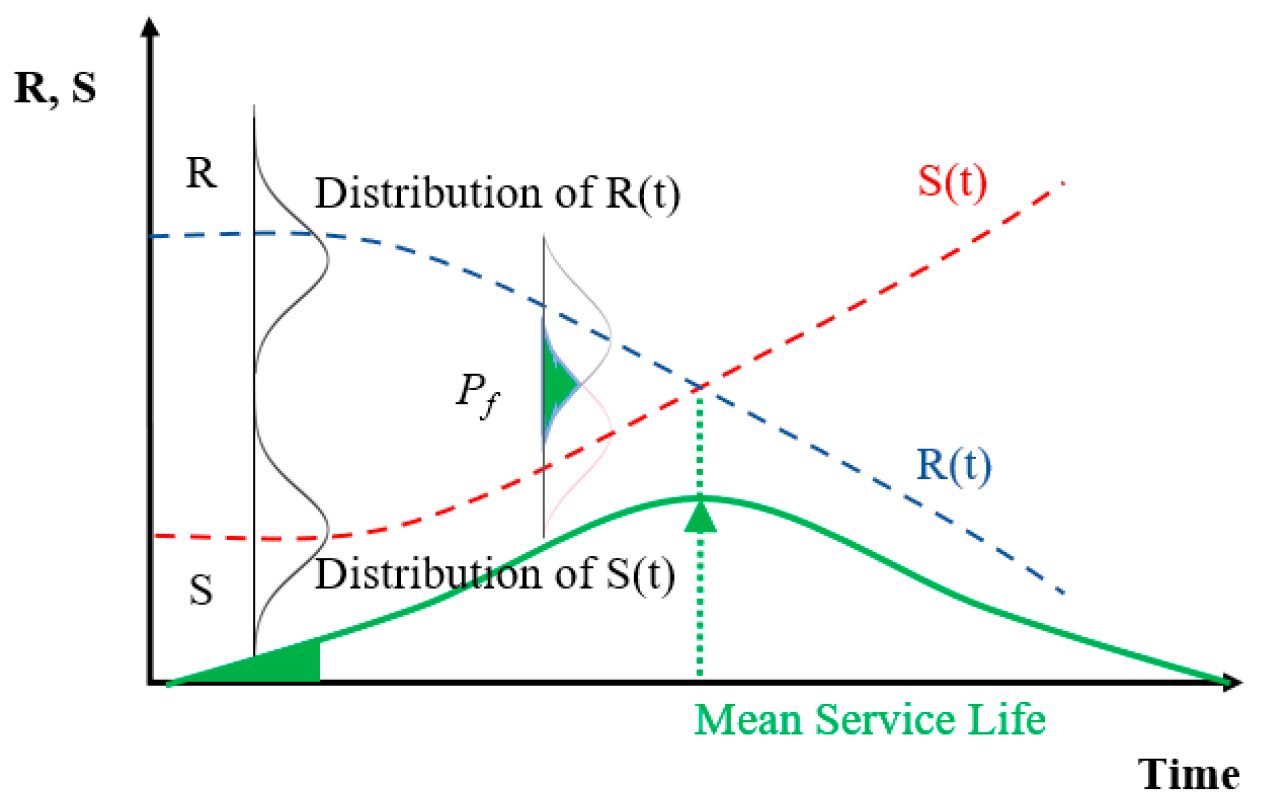
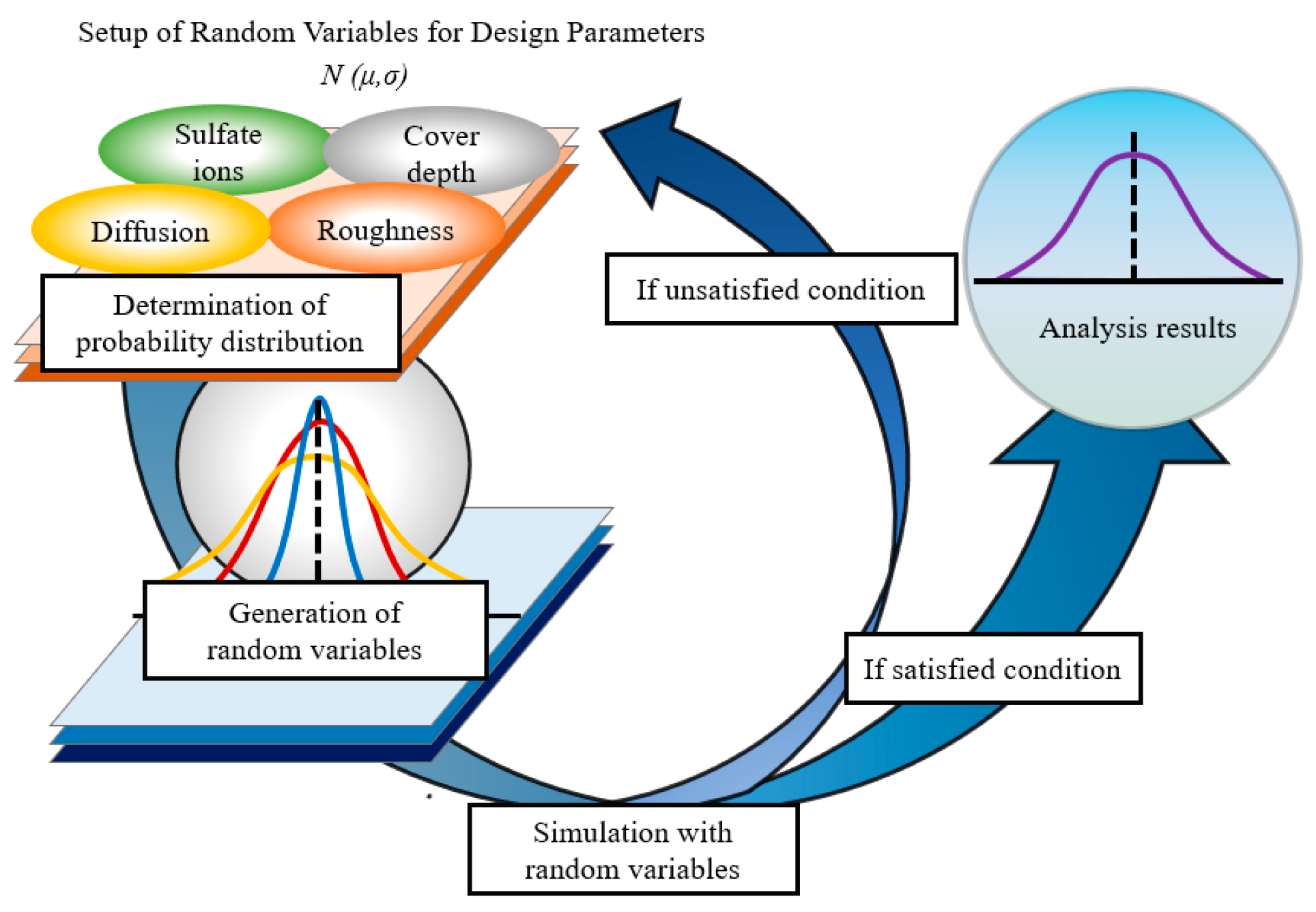

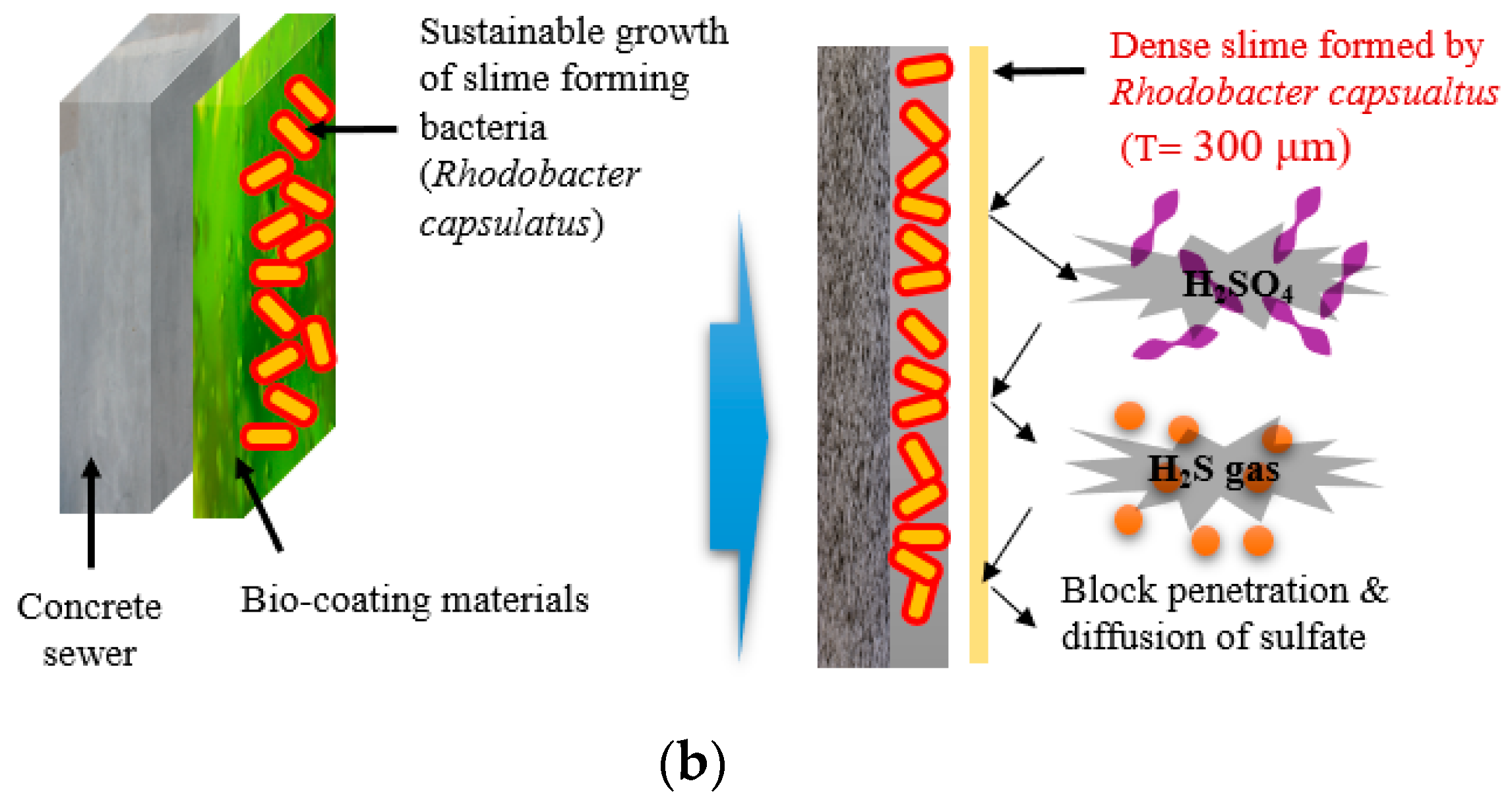
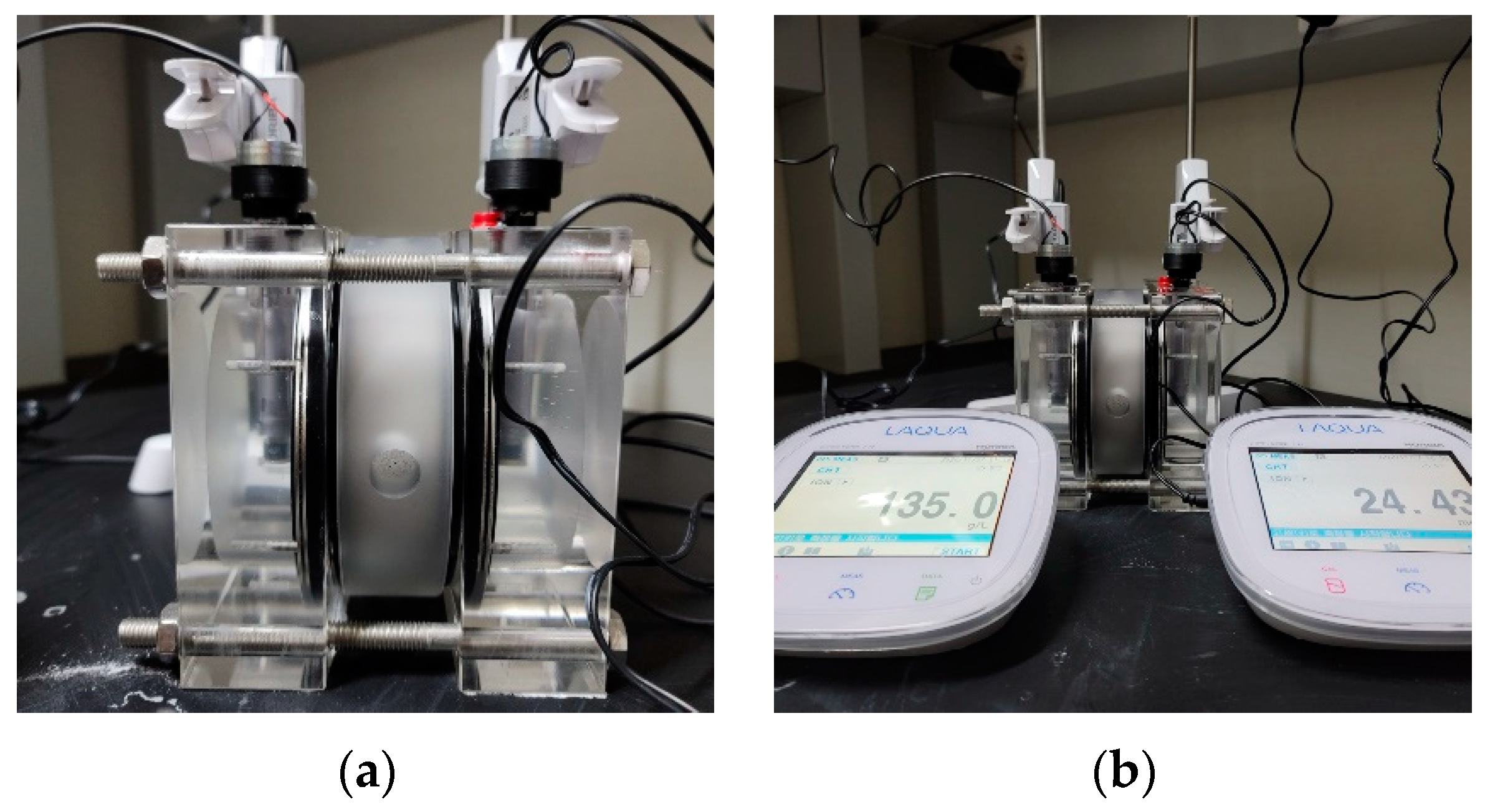



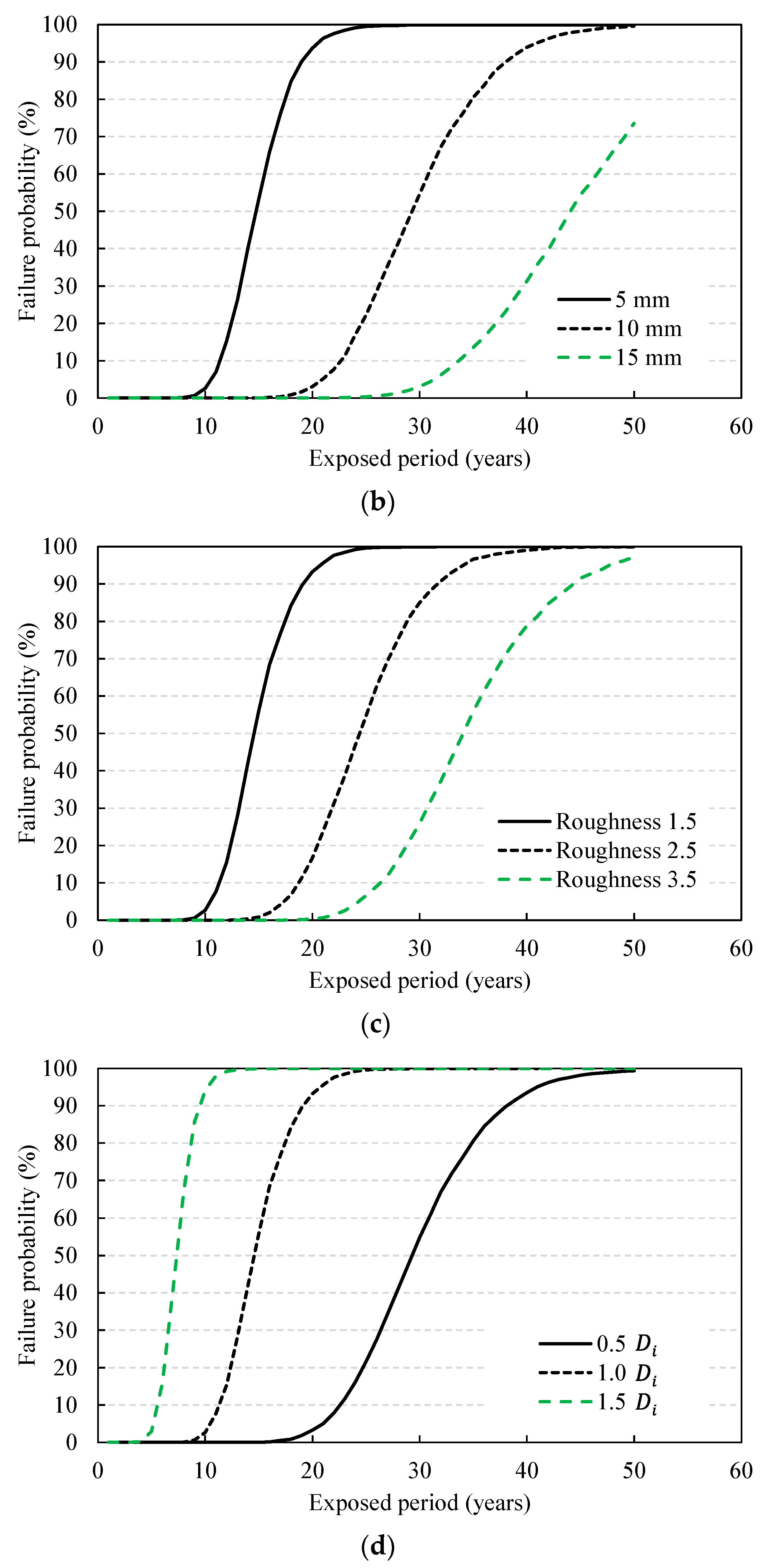
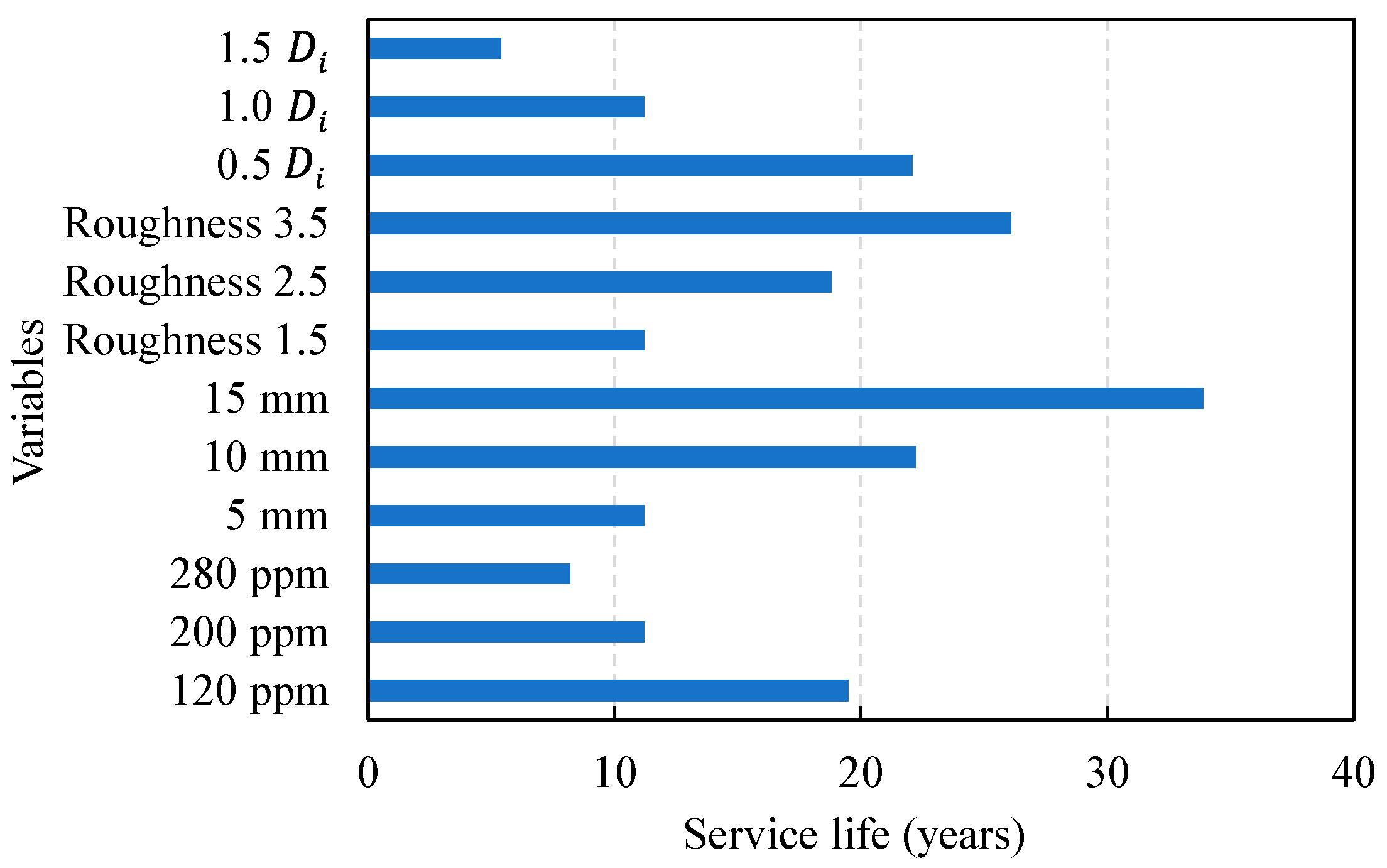
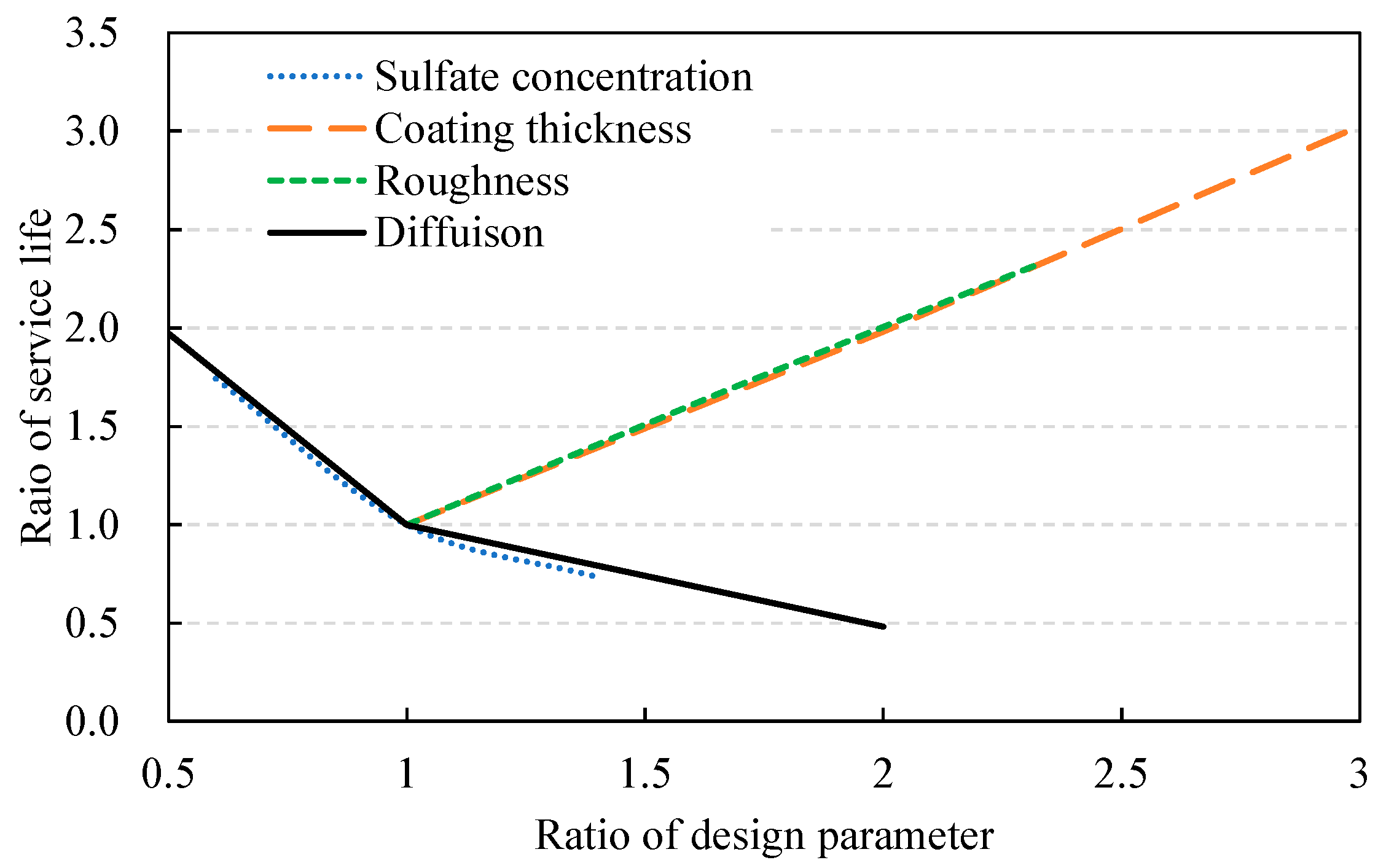
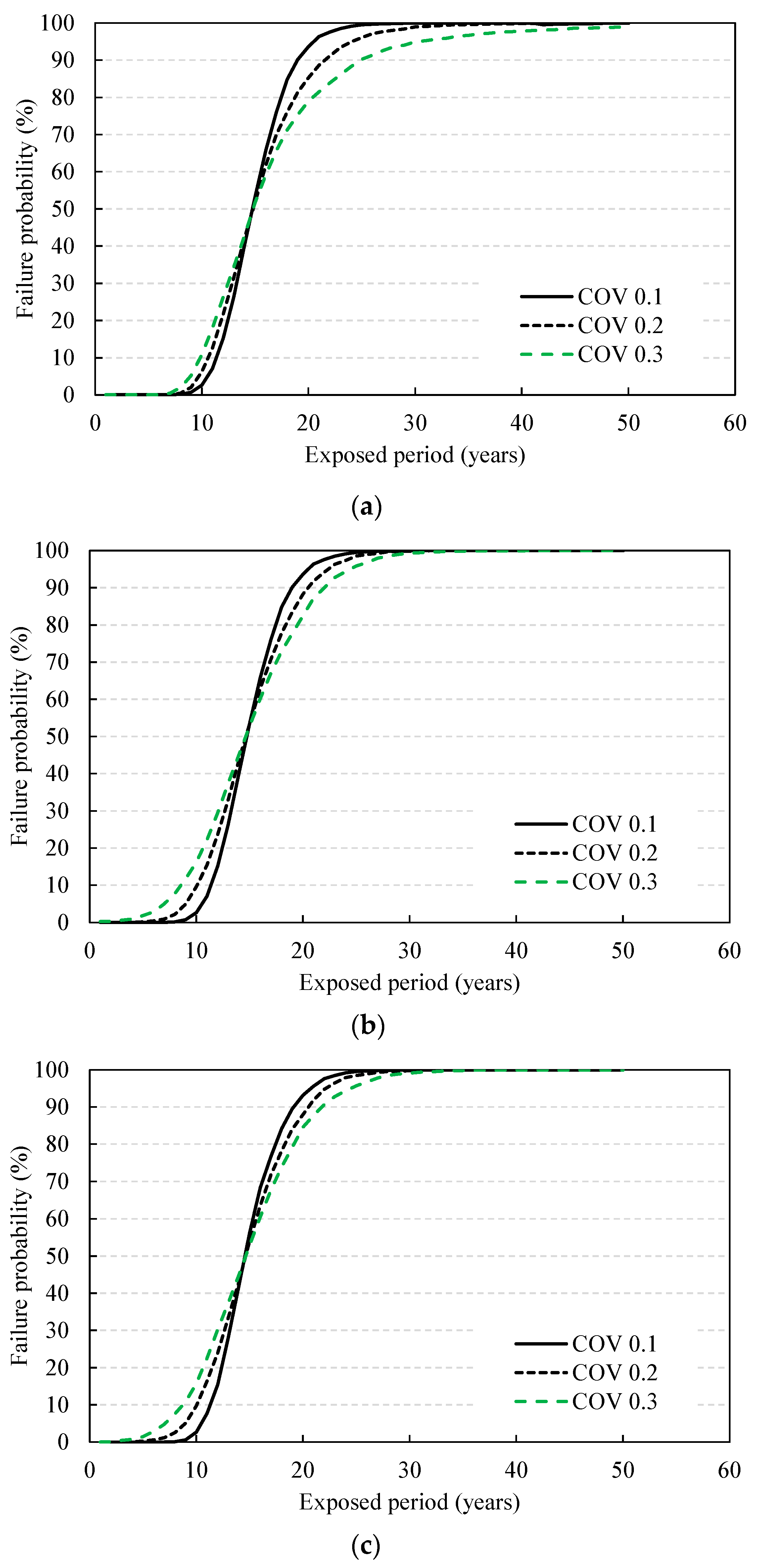
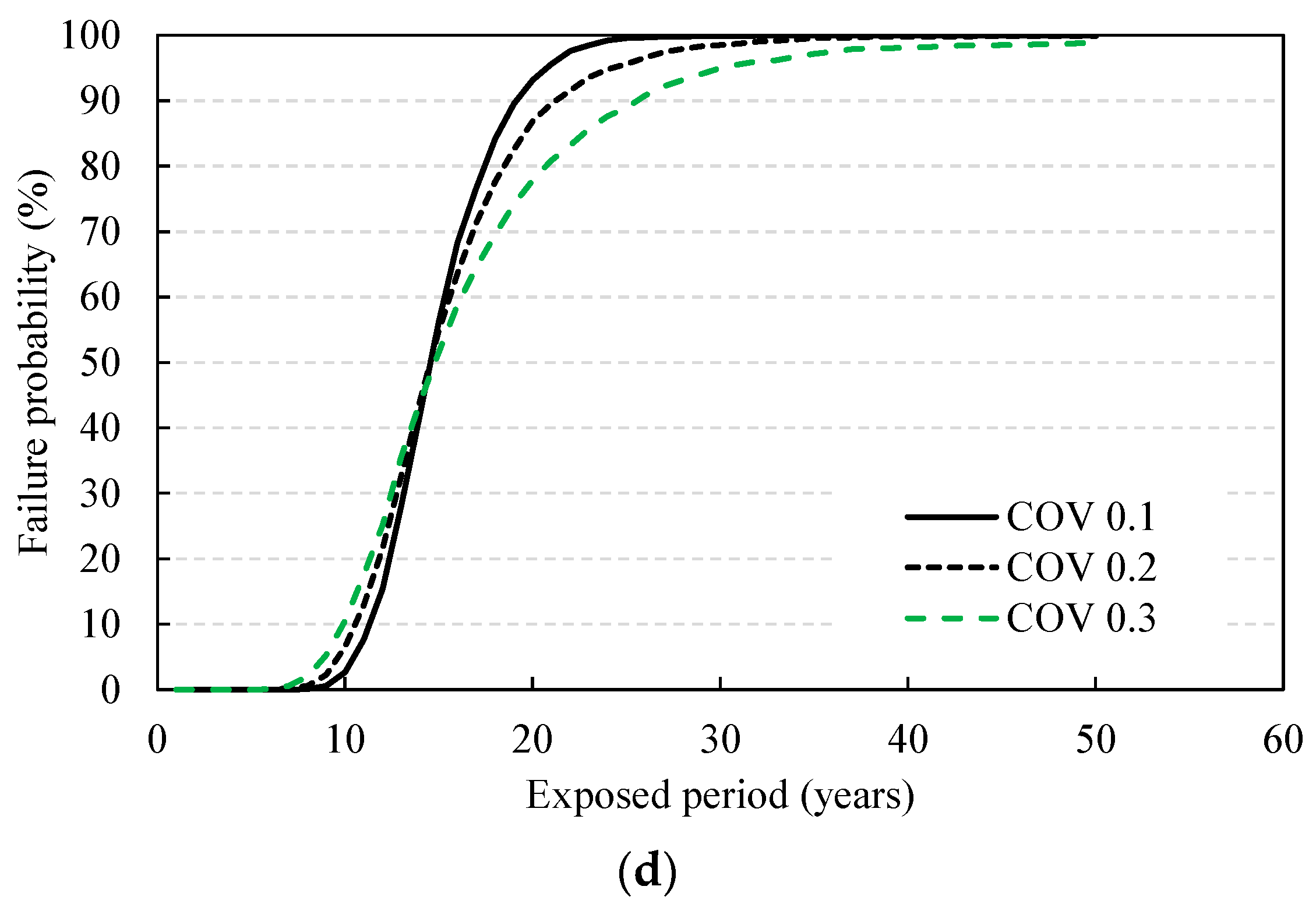
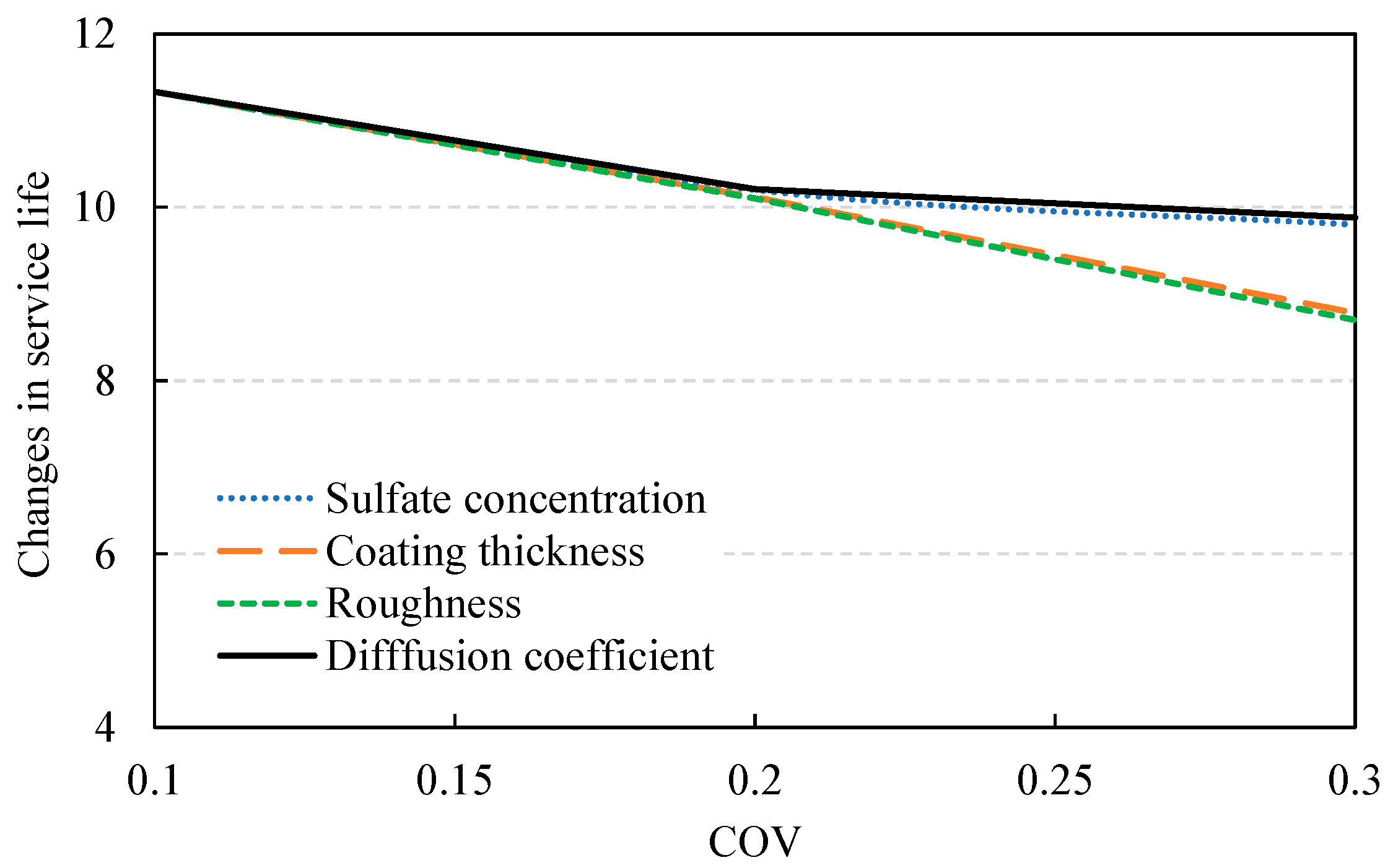
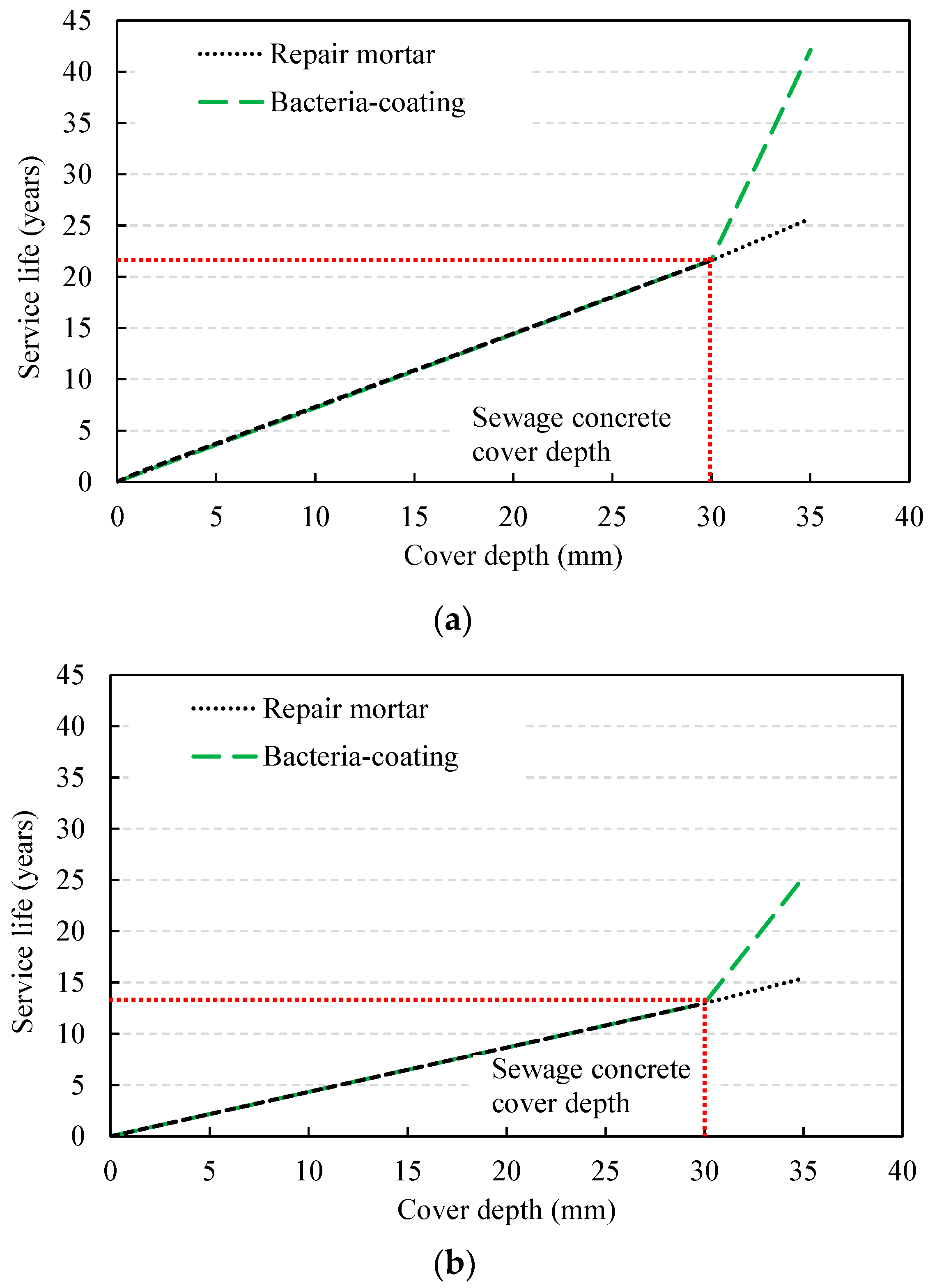
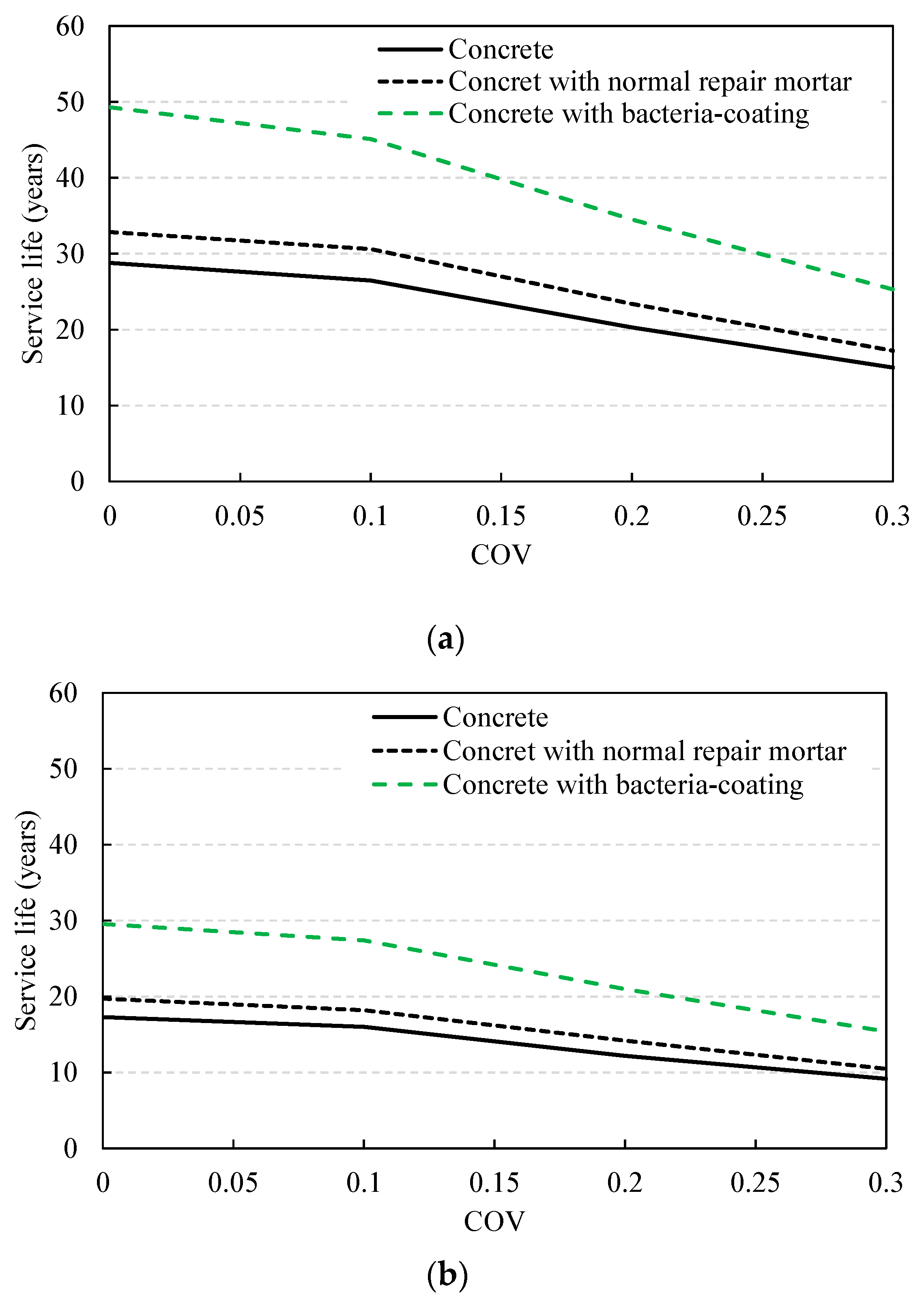
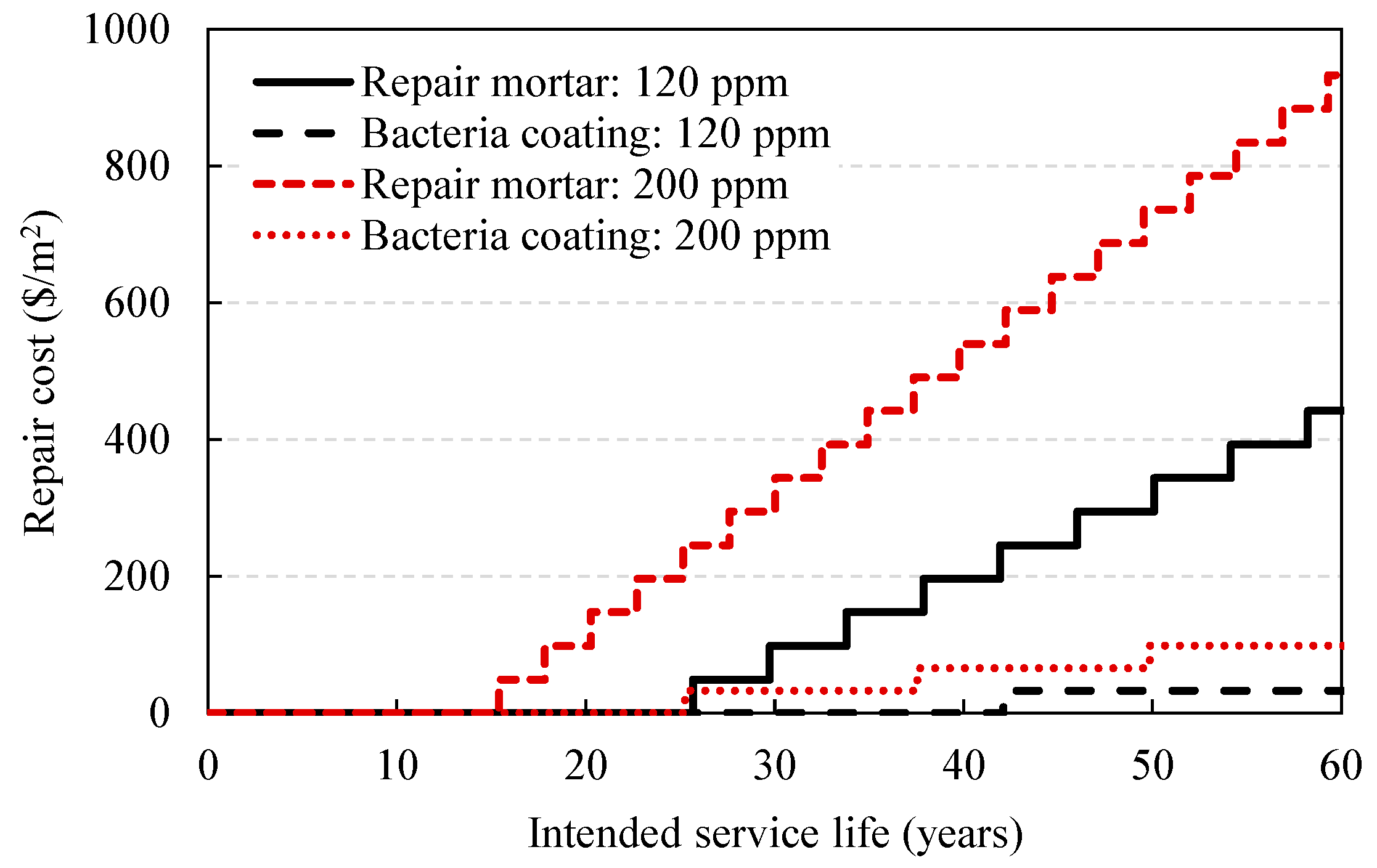
| Uncertainty Type | Limitation |
|---|---|
| Physical | Inherent random nature of a basic variables - Concrete cover depth - Concentration of exterior sulfate ions - Quality of concrete (diffusion coefficient of sulfate ion) - Local condition (cracks and joints) |
| Statistical | Assumption for probability density functions - Limited sample size |
| Model | Governing mechanism for deterioration by sulfate - Simplified equation of deterioration by sulfate without considering sulfuric reaction - Assumption of material properties (sulfurictable and reactant material) - Assumption of non-correlated variables |
| Decision | Definition of durability failure criteria - The period that carbonation depth exceeds the cover depth |
| Specimens | W/B (%) | S/B | Binder Mixing Ratio (%) | Replacement Ratio of Bacteria Carrier by the Volumetric Fraction of Sand (%) | ||
|---|---|---|---|---|---|---|
| OPC | FA | GGBFS | ||||
| Repair mortar | 35 | 2 | 35 | 20 | 45 | - |
| Bacteria-coating material | 35 | |||||
| W/C (%) | S/a (%) | Unit Weight (kg/m3) | |||
|---|---|---|---|---|---|
| Water | Cement | Sand | Gravel | ||
| 45 | 47 | 180 | 400 | 786 | 903 |
| Materials | Composition (wt.%) | |||||||||
|---|---|---|---|---|---|---|---|---|---|---|
| SiO2 | Al2O3 | Fe2O3 | CaO | MgO | SO3 | TiO2 | Na2O | K2O | LOI | |
| OPC | 21.7 | 5.3 | 3.1 | 62.4 | 1.6 | 1.7 | - | - | - | 0.8 |
| GGBFS | 33.5 | 15.2 | 0.5 | 45.6 | 2.6 | 2.5 | 0.9 | 0.2 | 0.4 | 0.7 |
| FA | 53.3 | 27.9 | 7.8 | 6.8 | 1.1 | 0.8 | - | 0.6 | 0.8 | 0.9 |
| Materials | Density (g/cm3) | Fineness (cm2/g) |
|---|---|---|
| OPC | 3.15 | 3260 |
| GGBFS | 2.94 | 4355 |
| FA | 2.23 | 3720 |
| Variables | Sewage Concrete | Repair Mortar | Bacteria-Coating Material |
|---|---|---|---|
| 200 | 200 | 200 | |
| 2.12 × 10−12 | 2.09 × 10−12 | 0.17 × 10−12 | |
| 25,700 | 21,500 | 21,500 | |
| 0.17 | 0.27 | 0.27 | |
| 1.5 | 1.5 | 1.5 | |
| 10 | 10 | 10 | |
| Binder weight | 400 | 300 | 300 |
| 207 | 196 | 462 | |
| Cover depth (mm) | 30 | 5 | 5 |
| Exterior Condition (Sulfate Concentration) | Deterioration Velocity (mm/Year) | ||
|---|---|---|---|
| Sewage Concrete | Repair Mortar | Bacteria-Coating Material | |
| 120 ppm | 1.16 | 1.03 | 0.20 |
| 200 ppm | 1.94 | 1.71 | 0.34 |
Publisher’s Note: MDPI stays neutral with regard to jurisdictional claims in published maps and institutional affiliations. |
© 2021 by the authors. Licensee MDPI, Basel, Switzerland. This article is an open access article distributed under the terms and conditions of the Creative Commons Attribution (CC BY) license (https://creativecommons.org/licenses/by/4.0/).
Share and Cite
Yoon, H.-S.; Yang, K.-H.; Lee, K.-M.; Kwon, S.-J. Service Life Evaluation for RC Sewer Structure Repaired with Bacteria Mixed Coating: Through Probabilistic and Deterministic Method. Materials 2021, 14, 5424. https://doi.org/10.3390/ma14185424
Yoon H-S, Yang K-H, Lee K-M, Kwon S-J. Service Life Evaluation for RC Sewer Structure Repaired with Bacteria Mixed Coating: Through Probabilistic and Deterministic Method. Materials. 2021; 14(18):5424. https://doi.org/10.3390/ma14185424
Chicago/Turabian StyleYoon, Hyun-Sub, Keun-Hyeok Yang, Kwang-Myong Lee, and Seung-Jun Kwon. 2021. "Service Life Evaluation for RC Sewer Structure Repaired with Bacteria Mixed Coating: Through Probabilistic and Deterministic Method" Materials 14, no. 18: 5424. https://doi.org/10.3390/ma14185424
APA StyleYoon, H.-S., Yang, K.-H., Lee, K.-M., & Kwon, S.-J. (2021). Service Life Evaluation for RC Sewer Structure Repaired with Bacteria Mixed Coating: Through Probabilistic and Deterministic Method. Materials, 14(18), 5424. https://doi.org/10.3390/ma14185424







